Whac-A… BOTTLE? Find out how this FUN campaign encouraged people to recycle! [Thursdays: Gorillas of Guerrilla Marketing]

Miles Everson’s Business Builder Daily speaks to the heart of what great marketers, business leaders, and other professionals need to succeed in advertising, communications, managing their investments, career strategy, and more.
A Note from Miles Everson:
Are you familiar with “Guerrilla Marketing?”
According to Jay Conrad Levinson, this marketing strategy is unconventional. It works effectively for various businesses because it’s engaging, easy to execute, and sometimes, inexpensive.
I personally enjoy encountering campaigns of this type because they make a huge impact and easily stick to consumers’ minds.
Allow us to share with you an example of a fun and clever guerrilla marketing strategy.
Read on to know another one of this automotive company’s marketing stunts under the “Fun Theory” campaign.
Miles Everson
CEO, MBO Partners
Chairman of the Advisory Board, The I Institute
Gorillas of Guerrilla Marketing
In marketing, there’s a strategy we call, “loss aversion.”
This is a cognitive bias that describes why for many consumers, pain or loss is psychologically more powerful than pleasure or gain.
According to an article from Diet ID, it is part of human nature to avoid pain and discomfort. This is why sometimes, even in the area of health, people choose or stick to the easier choice instead of the better or healthier choice because oftentimes, the latter is the uncomfortable one.
BUT!
Did you know there was a theory that claimed people’s behaviors towards the good choice change when FUN is brought into the picture?
In fact, automotive company Volkswagen made a 3-series guerrilla marketing campaign to prove this theory AND promote its cars’ eco-friendly technology!
In a past “Gorillas of Guerrilla Marketing” article, we featured one of Volkswagen’s “Fun Theory” campaigns:
The piano staircase.
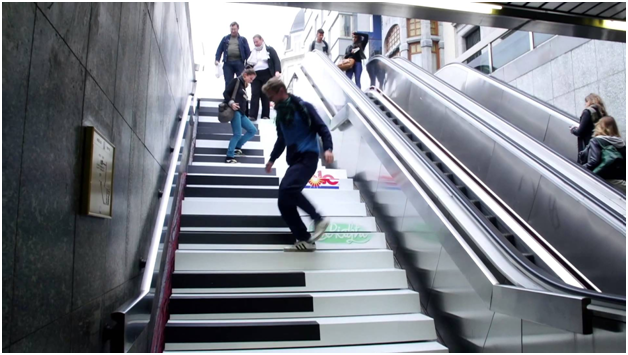
There, we discussed how the campaign team transformed an ordinary staircase at Sweden’s Odenplan Subway Station into a musical staircase so more people would be encouraged to use the stairs instead of the escalator beside it.
The result of the campaign?
The number of people who used the stairs at the subway station increased by 66%! This proved Volkswagen’s theory that “fun is the easiest way to get people to change their behavior for the better.”
Today, we’ll focus on another one of the automotive brand’s “Fun Theory” campaigns. It is called…
“The Bottle Bank Arcade Machine!”
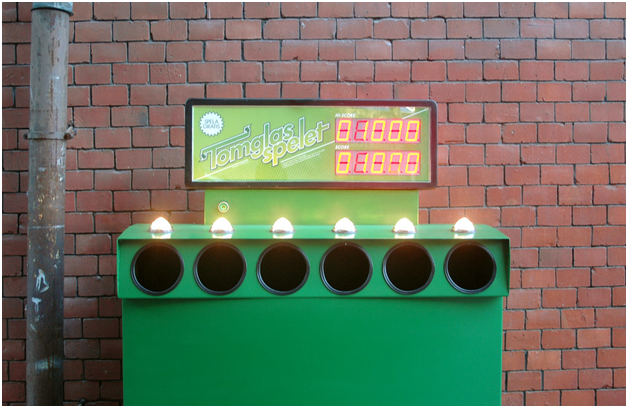
Conducted in Stockholm, Sweden in November 2009, the aim of the campaign was to continue to promote Volkswagen cars’ BlueMotion Technology AND get people to happily recycle plastic bottles.
Just a brief background: The BlueMotion Technology was released in 2009. Until now, it’s installed in Volkswagen cars to improve fuel efficiency and reduce emissions.
… and in case you haven’t noticed yet, this explains why the brand’s “Fun Theory” campaigns tackled public health and environment-friendly activities. The company wanted to communicate the message that its cars promote fun, health, and safety at the same time.
Here’s what Volkswagen did for its “Bottle Bank Arcade Machine” campaign:
Partnering with marketing agency DDB Stockholm, Volkswagen transformed one of the large bins at Stockholm’s city square into an arcade machine that collects plastic bottles.
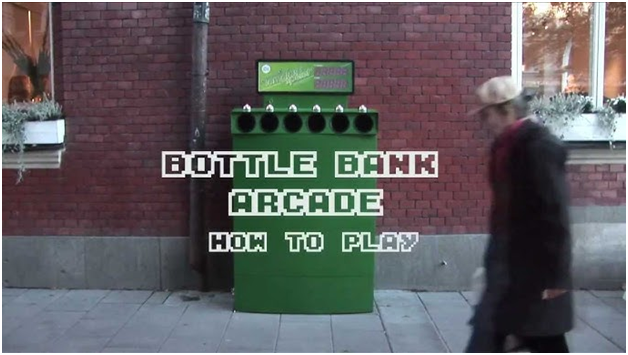
The concept was pretty much similar to a typical Whac-A-Mole game at arcades. Participants were instructed to press the Start button, then wait for the scoreboard and the lights above the holes to turn on before throwing plastic bottles into the bin.
Players must throw the bottles into the correct hole—the one with the light on—to score a point. Participants had to be alert because as the game progressed, the lights above the bin’s holes flickered faster, which meant they also needed to throw in the bottles more quickly.
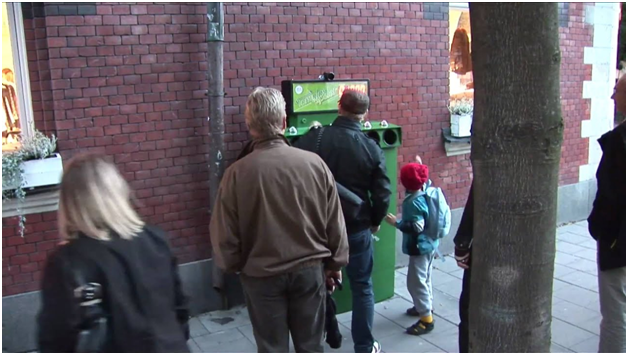
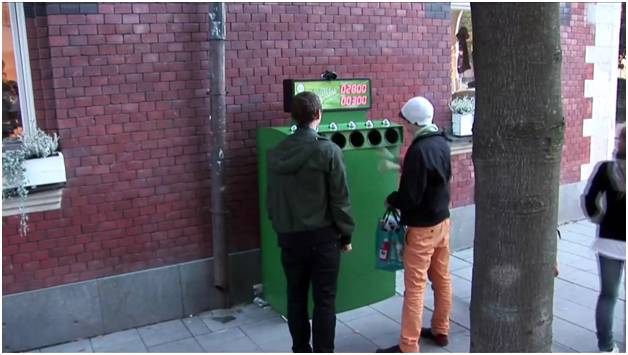
Lots of people flocked to the “Bottle Bank Arcade Machine.” Some even brought a bag full of plastic bottles with hopes to beat the high score! We bet these people also collected bottles from their neighbors or anywhere else just so they could play longer.
Other passersby also stopped on their tracks to watch and cheer for the players.
The campaign lasted for the entire month of November 2009. A hidden camera was installed in the area of the “Bottle Bank Arcade Machine” so the campaign team could record the reactions and activities of people there.
Once the campaign was done, Volkswagen and DDB Stockholm compiled all the footage and created a 2-minute video that was uploaded on YouTube.
Was Volkswagen’s “Bottle Bank Arcade Machine” effective?
Lots of passersby enjoyed using the improvised bin. Young and old alike did their part in collecting used plastic bottles and recycling them through the bottle bank.
You’d be delighted to see gray-haired people punching their fists into the air whenever they made a new high score! This showed that fun truly makes a positive difference in doing any activity.
Below are the results of the “Bottle Bank Arcade Machine” campaign:
- The campaign video garnered a total of nearly 3 million views and 6,000 likes on YouTube.
- The “Bottle Bank Arcade Machine” became part of AdForum’s ACT Responsible Collection.
- The campaign had a total of 6,000 social media impressions.
- Over 100 passersby used the improvised bin in the first 24 hours, whereas the typical bin near it only had 2 bottles in it at the end of the campaign’s first day.
- Throughout November 2009, a total of 10,000+ people recycled plastic bottles through the “Bottle Bank Arcade Machine” and over 100,000 bottles were collected.
Clearly, these results show that the campaign captured the attention of lots of passersby and effectively encouraged them to happily recycle plastic bottles.
Great job on this, Volkswagen and DDB Stockholm!
*Applause*
—
Environmental marketing has been growing and many companies are starting to adopt this as one of their strategies to capture consumers’ attention.
For instance: Volkswagen’s “Fun Theory” campaign aimed to get people to act responsibly in fun ways, such as encouraging people to recycle using the improvised bin. What’s more?
The campaign series became not just clever marketing strategies but also a way of thinking!
Through these, Volkswagen proved that when FUN is incorporated into a tedious task, people’s behavior changes. Personal enjoyment becomes the reward from doing such activity.
Think about it in the context of the “Bottle Bank Arcade Machine”: There wasn’t any material reward for those who achieved a high score. Despite that, a lot of people still continued to participate in the campaign because it’s fun and enjoyable.
Additionally, Volkswagen effectively tied its BlueMotion technology to its “Fun Theory” campaigns.
Through the “Bottle Bank Arcade Machine,” the brand communicated the message that it is an “eco-friendly, fun, and exciting company”—meaning, its cars are safe for both the public and the environment.
Get inspired with today’s guerrilla marketing topic!
Find out how you can incorporate FUN into your own brand’s marketing strategies and you’ll see—this will help you make a positive impression that sticks to your target market’s minds.
(This article is from The Business Builder Daily, a newsletter by The I Institute in collaboration with MBO Partners.)
About The Dynamic Marketing Communiqué’s
“Thursdays: Gorillas of Guerrilla Marketing”
Jay Conrad Levinson (1984) said that Guerrilla Marketing “works because it’s simple to appreciate, easy to execute, and inexpensive.”
Guerrilla Marketing is unconventional.
Looking beyond the traditional ways of advertising, marketers, and advertisers need to spice things up in order for their brand to have campaigns that not only make an impact but also stick to their target market’s mind.
Guerrilla Marketing usually aims to have direct contact with consumers.
This type of direct contact should spark an emotional reaction that leads to consumers effectively remembering the brand.
It’s about making a big impression and making that impression last a long time (if not forever).
Guerrilla Marketing can be inexpensive.
The effect of this is being able to create a buzz around the brand, and the strategy used to market it. Almost everything is passed around through word-of-mouth.
Word-of-mouth is one of the greatest outcomes and it usually doesn’t cost anything.
This is every business’ or brand’s dream!
Every Thursday, we publish tips, examples, and other useful content on unconventional ways of marketing and promotion.
Learn more about how to grab your target market’s attention and make an amazing first and lasting impression without having to spend a lot of money.
Businesses don’t really need to spend much for a guerrilla campaign. You do not need a big budget to be successful. You just need creativity and a good imagination.
Hope you’ve found this week’s guerrilla marketing insight interesting and helpful.
Stay tuned for next Thursday’s Gorillas of Guerrilla Marketing!
Cheers,
Kyle Yu
Head of Marketing
Valens Dynamic Marketing Capabilities
Powered by Valens Research
www.valens-research.com




